In the evolving conversation surrounding dietary wellness and preventive health, one question continues to surface among health-conscious individuals and nutrition professionals alike: Are nuts high in fiber, and if so, how does their fiber content contribute to digestive health? This seemingly simple query opens the door to a complex and enriching exploration of the nutritional profile of nuts, the various types of dietary fiber they contain, and the growing body of scientific evidence supporting their role in gut health and beyond. While nuts are often praised for their healthy fats and plant-based protein, their fiber content is an equally essential aspect of their value in modern nutrition.
You may also like: Macronutrients vs Micronutrients: What the Simple Definition of Macronutrients Reveals About Your Diet and Health
As Americans grapple with rising rates of gastrointestinal issues, including constipation, diverticulosis, and irritable bowel syndrome, understanding how daily food choices influence digestive function is more important than ever. Dietary fiber, long championed for its role in maintaining bowel regularity, regulating cholesterol levels, and promoting satiety, is commonly under-consumed in the United States. According to the Dietary Guidelines for Americans, most adults consume only half of the recommended daily intake. Within this context, the humble nut emerges not just as a convenient snack or garnish, but as a potent ally in the pursuit of better gut health. But to fully appreciate their fiber-related benefits, one must examine not only the amount but the type and function of fiber found in various nuts, as well as how they interact with the broader diet and microbiome.
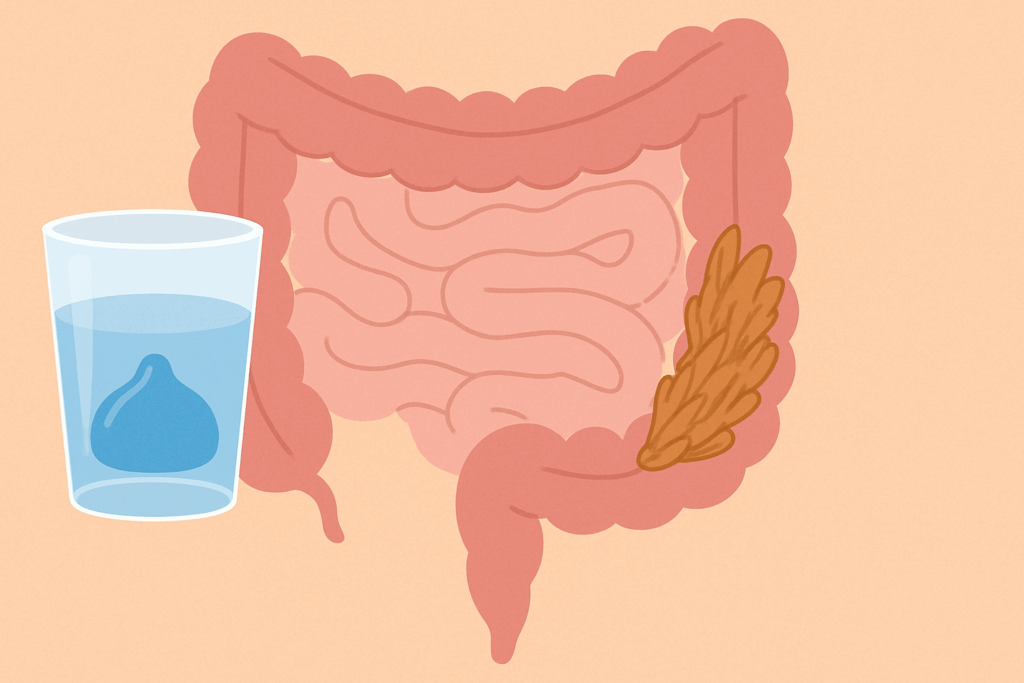
Understanding Fiber: Soluble vs. Insoluble and Why It Matters
To appreciate why the fiber content in nuts matters, it is crucial to first understand the distinction between soluble and insoluble fiber. Soluble fiber dissolves in water to form a gel-like substance and is known to help lower blood cholesterol and glucose levels. It also serves as a prebiotic, feeding beneficial gut bacteria that support immune function and intestinal integrity. Insoluble fiber, on the other hand, adds bulk to stool and promotes movement through the digestive tract, making it a key component in preventing constipation.
Do nuts have fiber that is mostly soluble, insoluble, or a combination of both? The answer varies by type. Almonds, for example, contain both forms, but they are richer in insoluble fiber, which is particularly effective for supporting bowel regularity. Walnuts also provide a combination of both types, though their soluble fiber content contributes meaningfully to heart health. Pistachios, cashews, and hazelnuts each offer unique fiber profiles, blending both forms in varying ratios that can complement diverse dietary needs.
By incorporating a mix of nuts into one’s daily eating pattern, individuals can naturally balance their intake of soluble and insoluble fibers. This balanced approach not only supports digestive comfort but also contributes to broader metabolic health by improving cholesterol levels, blood sugar regulation, and inflammatory response. When experts are asked, “Are nuts high in fiber?” the answer is resoundingly affirmative—but with the important caveat that not all nuts offer the same type or amount of fiber, underscoring the value of variety.
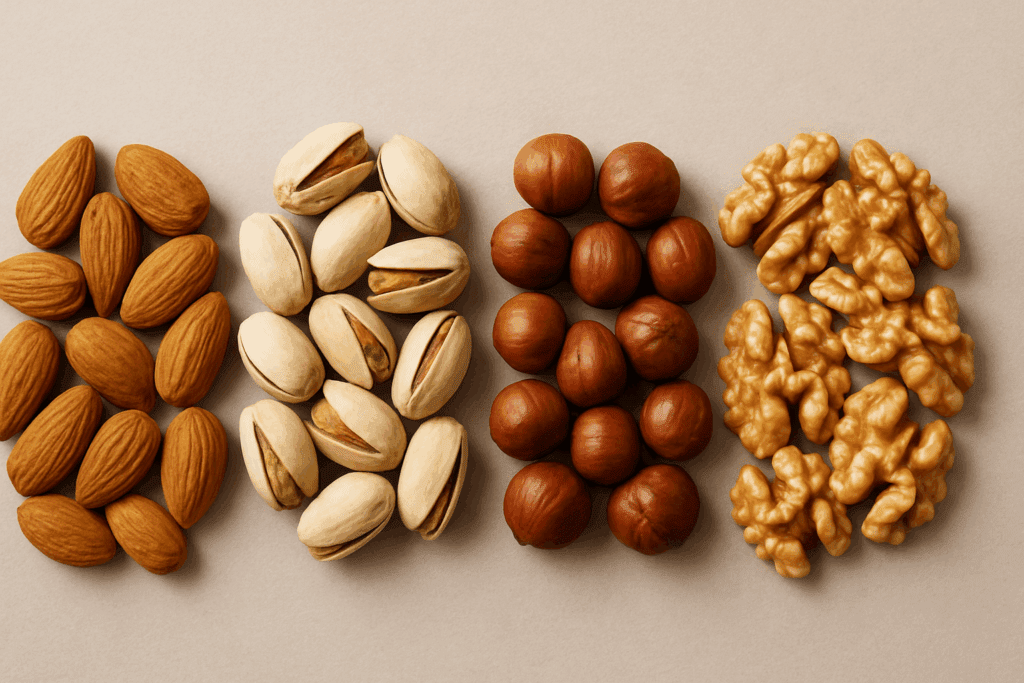
How Much Fiber Do Nuts Actually Contain?
The precise fiber content in nuts can differ significantly depending on the variety, processing methods, and serving size. Almonds are among the most fiber-rich nuts, with roughly 3.5 grams of fiber per one-ounce serving (about 23 almonds). Pistachios follow closely, offering about 2.9 grams per ounce, while hazelnuts provide approximately 2.7 grams. Even smaller nuts like pine nuts, though less fibrous, still contribute meaningfully with about 1 gram per serving.
When comparing fiber-rich foods, it’s worth noting that while nuts do not rival legumes or whole grains in sheer fiber density, they excel in offering fiber in a compact, calorie-dense form that is easy to integrate into meals and snacks. Moreover, because the fats in nuts are largely unsaturated and beneficial for heart health, they provide a dual function that makes them especially attractive from a preventive wellness perspective. Nutrition experts often emphasize this dual benefit when recommending nuts as part of a balanced, high-fiber diet.
The question “Do nuts have fiber in amounts that make a real difference?” is easily answered by observing the cumulative impact of even small servings. For example, a daily intake of a small handful of mixed nuts can contribute significantly toward the recommended 25 to 30 grams of daily fiber, especially when paired with fruits, vegetables, and whole grains. The key lies not in any one food alone but in the synergetic potential of diverse, nutrient-rich choices.
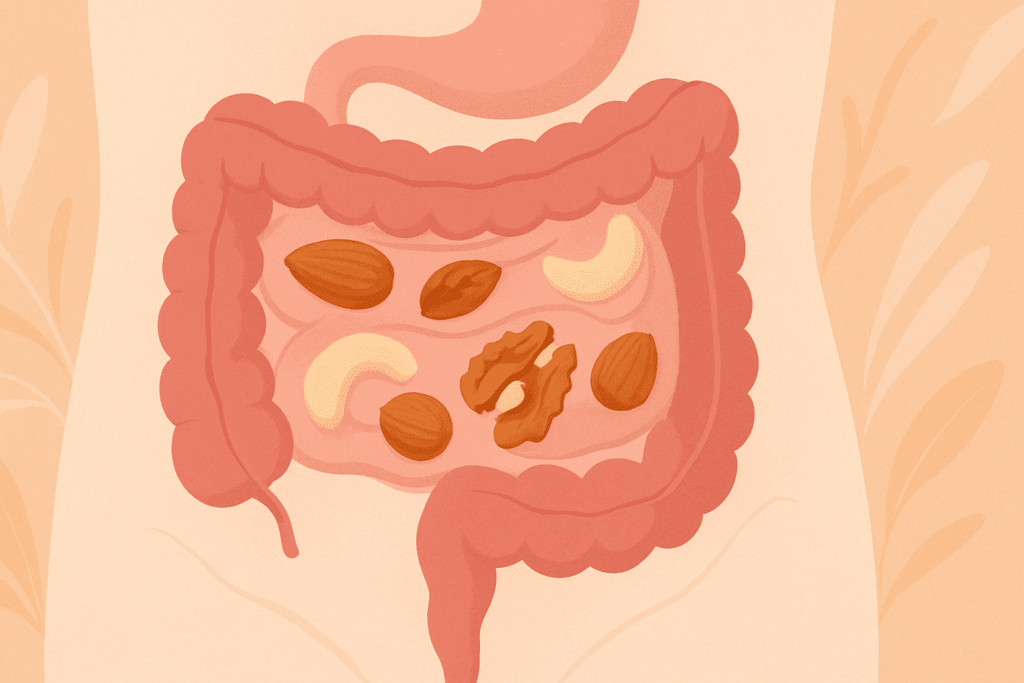
Digestive Health Benefits of Fiber in Nuts
The link between fiber and digestive health is well-established, but the specific contributions of nuts deserve closer attention. First, the insoluble fiber in nuts like almonds and walnuts promotes regular bowel movements by increasing stool bulk and reducing transit time through the intestines. This natural regulation is especially beneficial for individuals who suffer from sluggish digestion or occasional constipation.
Second, the soluble fiber in nuts acts as a prebiotic, nourishing the beneficial bacteria in the colon that form the foundation of a healthy microbiome. These bacteria produce short-chain fatty acids (SCFAs) during fermentation, including butyrate, acetate, and propionate, which have been linked to reduced inflammation, improved colonocyte function, and even mental well-being through the gut-brain axis. Thus, when asking, “Are nuts high in fiber in ways that improve gut flora?” the scientific consensus increasingly points to yes.
Third, nuts are naturally low in fermentable oligosaccharides, disaccharides, monosaccharides, and polyols (FODMAPs), making them suitable for many individuals with irritable bowel syndrome (IBS) who are sensitive to fiber-rich foods. The type of fiber in nuts is typically well-tolerated and can serve as a safe fiber source for people with mild to moderate gastrointestinal sensitivity. In this way, nuts support not only general digestive health but also the management of specific conditions.
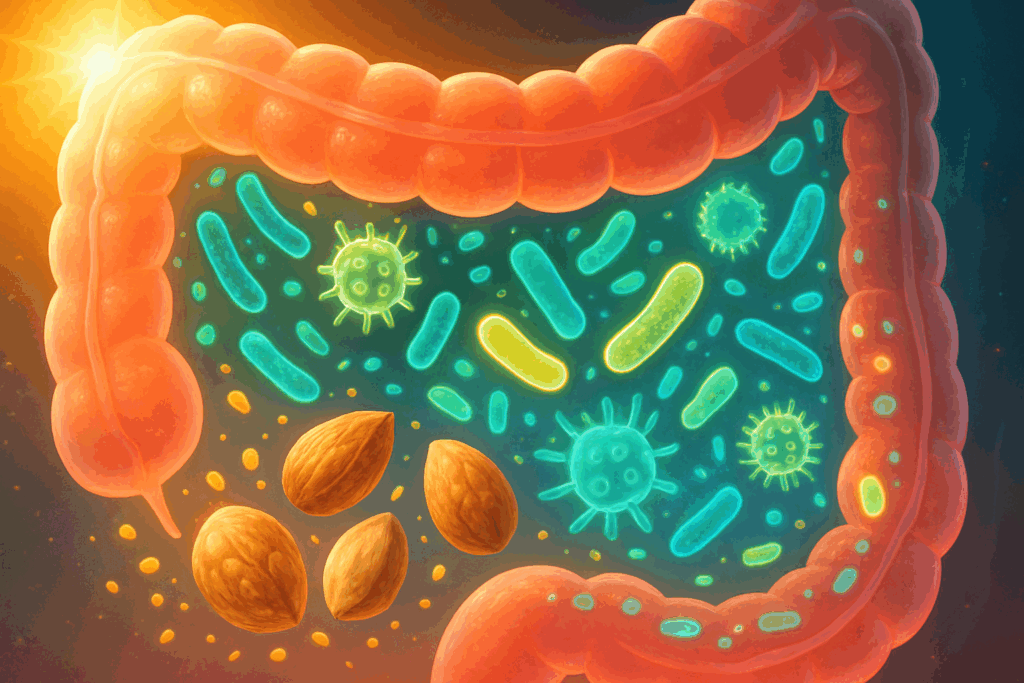
Nuts and the Microbiome: Supporting Gut Health Through Prebiotics
The relationship between nuts and the human microbiome represents an exciting frontier in nutrition science. As mentioned earlier, certain types of dietary fiber act as prebiotics, feeding the good bacteria that populate the gut and exert influence on everything from immunity to mental health. Recent studies have explored how different nuts affect the composition and function of these microbial communities.
One particularly notable finding is that pistachios and almonds, when consumed regularly, appear to increase the abundance of butyrate-producing bacteria, a key indicator of microbiome health. Butyrate is an SCFA known to reduce inflammation and support the integrity of the gut lining, which in turn helps prevent leaky gut syndrome and other inflammatory disorders. In clinical trials, participants who consumed these nuts daily experienced not only shifts in microbiota composition but also improvements in markers of gastrointestinal function.
Do nuts have fiber that directly supports microbial diversity? Yes, and it’s not just due to fiber content alone. Polyphenols, antioxidants naturally present in many nuts, also exert prebiotic-like effects by influencing microbial metabolism. Walnuts, for instance, are rich in ellagitannins, which gut bacteria convert into urolithins—compounds that may reduce inflammation and oxidative stress. The synergy between fiber and phytochemicals in nuts exemplifies how whole foods can offer layered benefits that go beyond macronutrients.

Practical Ways to Add More Fiber from Nuts Into Your Diet
Incorporating more nuts into your daily routine does not require radical dietary changes. Instead, subtle, consistent additions can yield significant benefits over time. A morning smoothie can be enriched with a tablespoon of almond butter or crushed walnuts for added fiber and texture. Salads take on greater satiety and digestive support when topped with pistachios or sunflower seeds. Even baked goods can benefit from finely ground hazelnuts or cashew flour, increasing both nutrient density and fiber content.
When planning snacks, a simple switch from processed granola bars to a small portion of mixed nuts and dried fruit can enhance fiber intake while avoiding unnecessary sugars and additives. Trail mixes can be customized to individual preferences, with combinations of high-fiber nuts like almonds and pecans paired with fiber-rich dried figs or apples. For those with nut allergies, seeds such as flaxseed and chia offer similar benefits and can be used as alternatives without sacrificing fiber content.
However, it is important to remember that nuts are calorie-dense, and portion control remains essential. Overconsumption can lead to unintended weight gain, which may offset the metabolic benefits of dietary fiber. Experts typically recommend a daily serving of one to two ounces of unsalted, dry-roasted or raw nuts to balance fiber intake with caloric needs. Pairing nuts with other high-fiber foods enhances overall intake and contributes to a well-rounded diet without overwhelming the digestive system.
Addressing Common Misconceptions About Nuts and Fiber
Despite growing awareness, several misconceptions about the fiber content of nuts persist. One of the most common is the belief that nuts are primarily a source of fat and protein, with negligible fiber. While it is true that nuts are rich in healthy fats and contain moderate protein levels, this narrow view overlooks their significant fiber contributions. Do nuts have fiber in meaningful amounts? Absolutely, and their role should be recognized alongside other plant-based fiber sources.
Another misunderstanding involves the idea that roasted or salted nuts are nutritionally inferior and lack fiber. While excessive sodium and added oils can compromise the overall health profile, the fiber content in roasted nuts remains largely intact unless they are heavily processed or coated in sugary glazes. The method of preparation may affect texture and flavor, but the essential dietary fiber remains resilient in most minimally processed forms.
Finally, some individuals fear that the fiber in nuts may be too harsh for sensitive digestive systems, leading to bloating or discomfort. In reality, most people tolerate nut fiber quite well, especially when introduced gradually and paired with adequate hydration. Compared to legumes or certain fibrous vegetables, the fiber in nuts tends to be gentler and less fermentable, reducing the likelihood of gastrointestinal distress in sensitive populations.
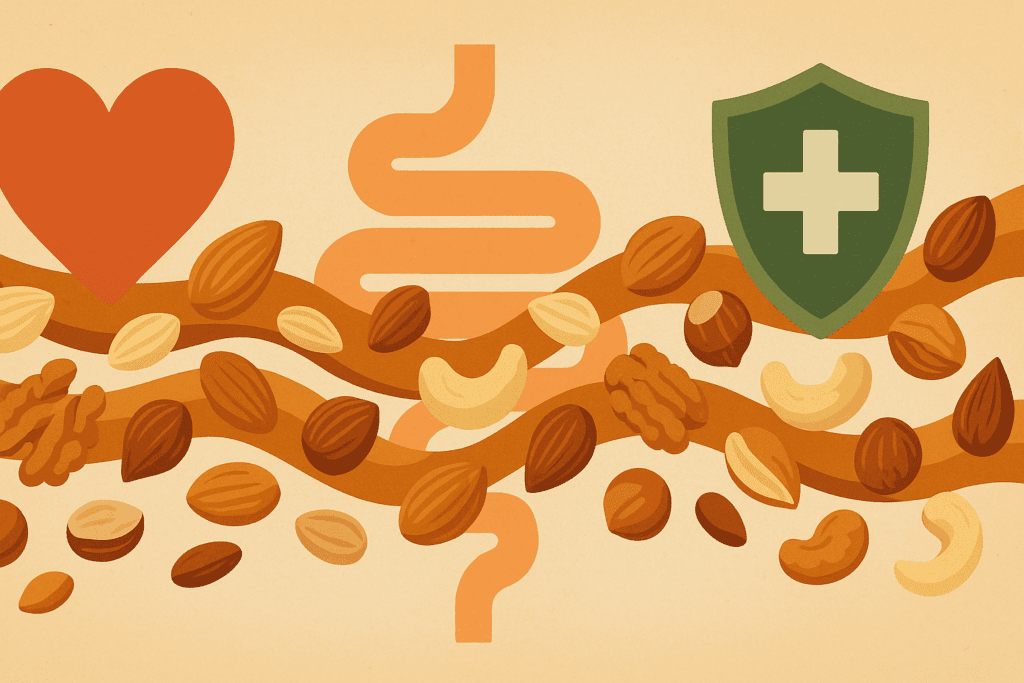
The Role of Nuts in High-Fiber Diets for Disease Prevention
A diet rich in fiber has long been associated with a lower risk of numerous chronic diseases, including heart disease, type 2 diabetes, colorectal cancer, and obesity. Within this framework, nuts offer a unique contribution by delivering fiber in a form that also contains heart-healthy monounsaturated fats, plant sterols, and antioxidants. When asked, “Are nuts high in fiber in a way that supports chronic disease prevention?” many healthcare providers point to extensive research affirming their protective role.
For cardiovascular health, the fiber in nuts helps reduce LDL cholesterol by binding to bile acids in the digestive tract, encouraging the liver to use more cholesterol to produce bile, thus lowering circulating levels. In terms of glycemic control, fiber slows carbohydrate absorption and reduces post-meal blood sugar spikes, which is critical for diabetes management. Additionally, the satiating effect of fiber helps regulate appetite, making it easier to maintain a healthy weight over time.
In cancer prevention, the prebiotic fiber in nuts may enhance the body’s ability to modulate inflammation and oxidative stress—two key drivers of carcinogenesis. While no single food can prevent cancer outright, the cumulative effect of fiber-rich, plant-based eating patterns has been associated with significant risk reduction. Thus, the inclusion of nuts within a high-fiber, whole-foods diet is both evidence-based and practical.
Frequently Asked Questions (FAQ): Fiber in Nuts and Digestive Health
1. Can eating nuts help improve long-term gut resilience?
Yes, regularly consuming nuts can contribute to long-term gut resilience by fostering a stable and diverse gut microbiome. While many people ask, “Do nuts have fiber?” they often overlook the long-term effects of this fiber on microbial balance. The fiber in nuts, especially when combined with their bioactive compounds like polyphenols, helps beneficial bacteria thrive and compete against pathogenic strains. Over time, this can result in a gut ecosystem that is more resistant to disruptions from antibiotics, stress, or poor diet. So not only are nuts high in fiber, but they also serve as part of a proactive digestive health strategy that supports microbial adaptability and intestinal homeostasis.
2. How do nuts compare to fiber supplements for digestive support?
Fiber supplements often provide isolated fibers such as psyllium husk or inulin, which have proven benefits but lack the complexity found in whole foods. When people ask, “Are nuts high in fiber compared to supplements?” the answer lies in understanding their synergistic nutrients. Nuts offer a combination of soluble and insoluble fiber, healthy fats, antioxidants, and plant sterols that work together to support digestion more holistically. Unlike synthetic supplements, the fiber in nuts is accompanied by real food matrices that slow digestion and improve nutrient absorption. Thus, when considering whether to choose fiber from food or supplements, it’s worth recognizing that not only do nuts have fiber, they also offer superior nutritional value due to their whole-food profile.
3. Are certain nuts better for managing stress-related digestive issues?
Absolutely. Chronic stress impacts gut function through the gut-brain axis, and nuts like pistachios and walnuts may offer calming benefits in addition to fiber content. Many wonder, “Do nuts have fiber that helps with stress-induced digestive issues?” The answer is yes—but there’s more. These nuts are rich in magnesium, which plays a critical role in nervous system regulation and muscle relaxation, including smooth muscle function in the intestines. Combining high-fiber nuts with stress-reducing nutrients may help alleviate issues like stress-related bloating or irregularity. This highlights how nuts are high in fiber while also being neurologically supportive, especially for stress-sensitive guts.
4. Can the fiber in nuts support hormone balance through the gut?
Emerging research in gut-endocrine interactions suggests that dietary fiber can help regulate estrogen metabolism and hormonal signaling. So, when exploring whether nuts are high in fiber with endocrine benefits, the evidence is promising. Nuts contribute to the regulation of hormones by supporting gut bacteria that assist in metabolizing excess estrogen, which is particularly important for individuals with hormone-sensitive conditions like PCOS or estrogen dominance. Because many of the beneficial gut bacteria rely on fermentable fiber, and nuts have fiber that feeds these microbes, they play a subtle but meaningful role in endocrine balance. Therefore, incorporating fiber-rich nuts into a hormone-conscious diet can have wider systemic implications beyond digestion alone.
5. How does roasting or soaking affect the fiber content in nuts?
Roasting nuts at moderate temperatures does not significantly reduce their fiber content, though excessive heat may degrade sensitive nutrients like vitamin E. When considering the question, “Do nuts have fiber that withstands processing?” the answer is largely yes. Soaking, on the other hand, can slightly alter the composition by leaching some soluble fibers into the water. However, this process also activates enzymes that may enhance digestion and nutrient absorption, making soaked nuts easier on sensitive stomachs. In short, nuts are high in fiber regardless of light roasting or soaking, but the way you prepare them can influence their digestibility and bioavailability in subtle ways.
6. Is it possible to get too much fiber from eating nuts daily?
While it’s unlikely that nuts alone would push fiber intake into excessive territory, overconsumption—especially in combination with other high-fiber foods—can sometimes lead to bloating or discomfort. The query “Are nuts high in fiber to a degree that could cause digestive issues?” reflects this valid concern. Moderation is key. Eating 1 to 2 ounces daily typically supports digestive health without overloading the gut, particularly if you hydrate adequately and spread your fiber intake across the day. It’s also essential to increase fiber gradually. Even though nuts have fiber, they should be part of a diversified fiber strategy, not the sole source.
7. How can individuals with nut allergies get similar fiber benefits?
For those who cannot consume nuts due to allergies, several seeds offer comparable benefits. Pumpkin seeds, chia seeds, and sunflower seeds are excellent alternatives and are often better tolerated. When individuals ask, “Do nuts have fiber that seeds can replicate?” the answer is yes, particularly in terms of insoluble content. Seeds also provide plant-based omega-3s and lignans, which contribute to both gut and cardiovascular health. Though seeds vary slightly in fiber composition, their integration into the diet can mimic many of the gut-friendly effects found in nuts. So, while nuts are high in fiber, seeds present a valuable and safe option for allergy-sensitive individuals.
8. Can high-fiber nuts play a role in post-antibiotic gut recovery?
Post-antibiotic care often focuses on replenishing lost beneficial bacteria, and diet plays a critical role in that recovery. One might ask, “Are nuts high in fiber types that help restore the microbiome after antibiotics?” Indeed, they are. The fiber in nuts, particularly the prebiotic kind found in almonds and pistachios, serves as nourishment for recolonizing gut flora. Moreover, the polyphenols in these nuts offer antioxidant support that helps reduce residual inflammation caused by antibiotic exposure. Including fiber-rich nuts in a recovery plan alongside fermented foods and hydration can significantly improve gut resilience and functionality during and after antibiotic therapy.
9. How do nuts fit into high-fiber diets for older adults?
Aging adults often struggle with constipation and reduced appetite, making compact, nutrient-dense foods particularly valuable. Since many ask, “Do nuts have fiber in forms suitable for seniors?” it’s important to note that nuts offer easily chewable and digestible options when prepared properly. Ground or finely chopped nuts, as well as nut butters, allow older adults to benefit from fiber without compromising dental or digestive comfort. Because nuts are high in fiber and rich in magnesium and unsaturated fats, they support both regularity and cognitive health—two key concerns in aging populations. Incorporating them into smoothies, yogurt, or oatmeal makes them accessible and enjoyable.
10. Are there any future innovations involving nut fiber in functional foods?
Absolutely. As the food industry continues to explore functional nutrition, researchers are investigating how the fiber in nuts can be isolated and used in new formulations. This raises the question, “Are nuts high in fiber sources that can be extracted for gut-targeted products?” Yes, and some companies are already exploring nut-based prebiotic powders and snack bars with enhanced fiber content. Additionally, innovations in plant-based milks are leading to fortified versions using almond or walnut fiber to boost digestive benefits. The versatility of nut-derived fiber holds promise not only for digestive health but also for chronic disease prevention in next-generation functional foods.
Conclusion: Do Nuts Have Fiber That Supports Digestive Wellness and Disease Prevention?
As the evidence continues to mount, it becomes increasingly clear that the answer to the question “Are nuts high in fiber?” is a resounding yes—one that carries implications far beyond bowel regularity. The fiber found in nuts contributes not only to a smoother, more efficient digestive process but also supports a healthy microbiome, enhances nutrient absorption, and reduces risk factors for chronic disease. Whether we consider their role in heart health, metabolic regulation, or cancer prevention, the multifaceted nature of nut-based fiber becomes evident.
From a nutritional standpoint, nuts offer a powerful combination of fiber, healthy fats, plant protein, and bioactive compounds that work together to promote holistic well-being. The fact that they can be easily integrated into a wide variety of meals, snacks, and dietary patterns only enhances their practicality. When consumed in mindful portions and combined with other fiber-rich foods, nuts stand as an essential component of a digestive health strategy grounded in science and enriched by culinary versatility.
So, do nuts have fiber in amounts that warrant their place in a high-fiber diet? Unquestionably. And when chosen wisely and consumed regularly, nuts can serve not only as a delicious addition to daily meals but also as a scientifically grounded ally in the ongoing effort to improve digestive wellness and prevent chronic illness through nutrition.


